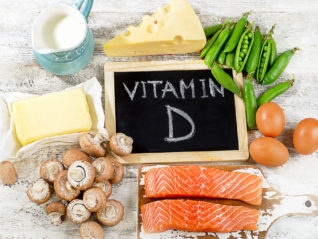
Ashley Jordan Ferira, PhD, RDN
If you can have a favorite nutrient, mine would be vitamin D.
Historically famous for its essential, classical role in calcium and phosphorus homeostasis and bone physiology (think rickets prevention), the past few decades of research have unveiled diverse, extraskeletal health roles for vitamin D, including but not limited to the immune system, cardiometabolic pathophysiology, cancer, pregnancy, etc.
Whether consuming vitamin D2 or D3 (FYI, the latter more potently impacts vitamin D status),1 vitamin D ultimately circulates in the 25-hydroxyvitamin D [25(OH)D] form (the clinical biomarker used to measure vitamin D status) and acts throughout the body as a pleiotropic hormone in its active form, 1,25-dihydroxyvitamin D [1,25(OH)2D].
Unlike other nutrients, this fat-soluble vitamin is obtainable via several unique routes: the skin with adequate UVB exposure, a handful of natural food sources, a few fortified foods, dietary supplements, and even prescription drugs.
The problem is that few foods naturally contain vitamin D (e.g., egg yolk, certain fatty fish, fish liver oil, and certain species of UV-irradiated mushrooms), and fortified foods offer relatively small amounts (e.g., 100 IU vitamin D per 8 oz cup of fortified milk or orange juice),2 so vitamin D supplementation becomes a strategic solution. In the eloquent words of pediatrician and vitamin D researcher, Carol Wagner, MD: “Something so simple- vitamin D supplementation- could improve the health status of millions and so becomes an elegant solution to many of our health problems today.”
If it’s possible to be defensive of a micronutrient, I am protective of vitamin D. Non-evidence-based rumors and negative media attention targeting vitamin D are common. Some of the misinformation is hype from anti-supplement camps who make broad, sweeping statements that lack scientific substantiation. But not all of the vitamin D myths originate from bias or lack of intellectual rigor. After all, who has time to keep up with the impressive, daily output of new vitamin D research? Clinicians certainly do not have the luxury of time, not in the current healthcare paradigm. Nevertheless, when inaccurate conclusions are propagated to patients about vitamin D and their health, that’s more harm than good. So, let me help out.
This blog series explores some of the most common vitamin D myths. Let’s tackle just 1 myth today:
Myth: I get enough vitamin D from food, so I don’t need a vitamin D supplement.
Can you meet your vitamin D needs from food alone? Well, that depends on how you define “needs.” Let’s talk about the 2 major (and quite different) sets of vitamin D recommendations.
First, the National Academy of Medicine (NAM), formerly known as the Institute of Medicine, provided vitamin D Recommended Dietary Allowances (RDAs) in 2010.3 Here’s how much vitamin D NAM says that we (Americans and Canadians) need based on bone health research (think rickets and osteomalacia prevention, calcium absorption, etc.):3
- Infants (0-1 year): 400 IU/day
- Children and Adults (1-70 years): 600 IU/day
- Older Adults (71+ years): 800 IU/day
But I have a bone to pick (pun intended) with NAM’s vitamin D recommendations. I find them to be problematic, if not contradictory at times, for a few key reasons.
To start with, the RDA is by definition “the average daily level of intake sufficient to meet the nutrient requirements of nearly all (97-98%) healthy people.”4 Well, that misses the unhealthy people. Since 2/3rd of the country are overweight or obese5 and heart disease and cancer are the #1 and #2 causes of mortality in the US, respectively,6 one can extrapolate that the vitamin D RDAs do not apply to a decent chunk of the gen pop.
In fact, research indicates that overweight and obese individuals require more vitamin D than their lean counterparts,7 but the NAM recommendations fail to consider adiposity.
Second, lumping a toddler and 68-year-old grandmother in the same RDA category (i.e., ages 1-70 years) seems to lack nuance. Skeletal health is critical throughout life, but you cannot tell me that the vitamin D needs for the rapidly accruing skeleton in childhood and adolescence are no different than an adult or older adult’s skeletal needs.
Third, the RDAs for daily vitamin D intake are simply incongruent with the serum 25(OH)D cutoffs NAM also published in 2010. They provided the following 25(OH)D ranges:
- Deficiency: ≤ 12 ng/mL
- Insufficiency: 12-19 ng/mL
- Sufficiency: ≥ 20 ng/mL
The somewhat ironic problem is that the overly conservative vitamin D RDAs won’t get you into the 25(OH)D range that NAM defines for sufficiency. Regular UVB sun exposure (with adequate skin surface area, right latitude, right time of year, etc.) can raise serum D levels into sufficiency, except cutaneous vitamin D synthesis from sun is highly variable and limited for many. But 400-800 IU/day of vitamin D simply won’t do the trick. It’s like asking someone to fill up an 30-gallon fish tank and giving them a few cups of water to do the trick.
In the sage words of the late Bob Heaney, MD: “We’ve been able to show that the (vitamin D) RDA barely budges the blood 25-hydroxyvitamin D level.”8 Thanks to Dr. Heaney, who made invaluable research contributions to the field of vitamin D, we know that 100 IU/day of vitamin D increases serum 25(OH)D concentrations by approximately 1 ng/mL.9 That means that 1,000 IU/day of vitamin D would raise 25(OH)D by about 10 ng/mL. Although weight status, age, and the patient’s baseline vitamin D status can variably impact the supplementation response, this “rule of thumb” can be used to roughly calculate vitamin D supplementation needs.
For example, let’s take a patient: me. I have limited UVB sun exposure and consume some foods that contain vitamin D (e.g., milk, eggs, salmon) but irregularly. My daily 5,000 IU vitamin D3 supplement has my serum 25(OH)D at 54 ng/mL. It stays between 50-60 ng/mL, which is in the sufficient range.
But I’m an anomaly. Nationally representative research backs up the fact that Americans are not getting adequate vitamin D from their diets.10-11 First, 93% of Americans 2 years and older are failing to consume at least 400 IU/day of vitamin D from diet alone, and this estimate includes fortified food sources.10 Even when diet plus sun exposure are both thrown into the mix, about 1/3rd of the US population has serum 25(OH)D levels associated with vitamin D insufficiency or deficiency.11 For more details on vitamin D deficiency and why it persists, check out this blog.
Dietitians (I am one) and other clinicians love to preach “food first.” That slogan is true but ignores research on key nutrient gaps. I prefer to say, “food first, then fill the gaps.” And in the case of vitamin D, the gap is practically guaranteed, except for the outlier patient who’s knocking back fish liver oils and irradiated mushrooms.
Lastly, a more current and scientifically and clinically nuanced set of guidelines exist. One year after the NAM recommendations were released, several of the world’s leading vitamin D researchers convened to review the evidence to date, resulting in the 2011 publication: Evaluation, Treatment, and Prevention of Vitamin D Deficiency: An Endocrine Society Clinical Practice Guideline.12
The US Endocrine Society’s conclusions are harmonious with the mindset of a clinician, who is tasked with addressing the vitamin D needs of unique patients. The guideline recommends higher daily vitamin D levels than NAM, with a different and logical purpose in mind: Raising serum 25(OH)D levels into the sufficient range (≥ 30 ng/ml):12
- Infants (0-1 year): At least 1,000 IU/day
- Children and Adolescents (1-18 years): At least 1,000 IU/day
- Adults (19+ years): At least 1,500 – 2,000 IU/day
The US Endocrine Society also provided the following 25(OH)D cutoffs:12
- Deficiency: ≤ 20 ng/mL
- Insufficiency: 21-29 ng/mL
- Sufficiency: ≥ 30 ng/mL
The guidelines even differentiate vitamin D needs based on adiposity: Children and adults who are obese may need 2-3 times more vitamin D daily than normal-weight individuals.12 Finally, the US Endocrine Society provides clear guidance for correcting vitamin D deficiency in all age groups, with repletion and maintenance dosing information, which is a topic that I will cover in a future blog.
Individual genetic differences for the vitamin D receptor (VDR) (i.e., gene polymorphisms like Cdx2, Apa1, Fok1, Taq1) are another important facet to weave into each patient’s unique vitamin D story, underscoring the prudence of a personalized lifestyle medicine approach to treat the individual.
Takeaway:
No, you cannot satisfy your vitamin D needs from food alone. If you plan to raise and maintain your serum 25(OH)D level (the biomarker that indicates vitamin D status) in the sufficient range for skeletal and extraskeletal health, that will require daily vitamin D supplementation. Remember, 30 ng/mL is not the goal. It’s the cutoff for insufficiency.
Here’s a sneak peak at some of the additional vitamin D myths that will be covered in future blogs:
- It doesn’t matter what kind of vitamin D form you consume in food or supplements; vitamin D2 and D3 are the same.
- Vitamin D is a fat-soluble vitamin, so it’s toxic when you take too much!
Do you have a question about the science and clinical application for vitamin D? Let me know by commenting below!
Citations
- Tripkovic L et al. Comparison of vitamin D2 and vitamin D3 supplementation in raising serum 25-hydroxyvitamin D status: a systematic review and meta-analysis. Am J Clin Nutr. 2012;95:1357-1364.
- Bendik I et al. Vitamin D: a critical and essential micronutrient for human health. Front Physiol. 2014;5:248.
- National Academy of Medicine. Food and Nutrition Board. Dietary Reference Intakes for Calcium and Vitamin D. National Academy Press. Washington, D.C. 2010.
- NIH. https://ods.od.nih.gov/Health_Information/Dietary_Reference_Intakes.aspx. Accessed December 18, 2018.
- CDC. https://www.cdc.gov/obesity/data/adult.html. Accessed December 19, 2018.
- CDC. https://www.cdc.gov/nchs/fastats/leading-causes-of-death.htm. Accessed December 19, 2018.
- Pourschahidi LK. Vitamin D and obesity: current perspectives and future directions. Proc Nutr Soc. 2015;74(2):115-124.
- Interview. http://jeffreybland.com/knowledgebase/september-2004-issue-robert-p-heaney-md-john-a-creighton-university-professor/. Accessed December 3, 2018.
- Heaney RP et al. Human serum 25-hydroxycholecalciferol response to extended oral dosing with cholecalciferol. Am J Clin Nutr. 2003;77(1):204-210.
- Fulgoni VL et al. Foods, fortificants, and supplements: where do Americans get their nutrients? J Nutr. 2011;141:1847-1854.
- Looker AC et al. Vitamin D status: United States, 2001-2006. NCHS Data Brief. 2011(59):1-8.
- Holick MF et al. Evaluation, treatment, and prevention of vitamin D deficiency: an Endocrine Society clinical practice guideline. J Clin Endocrinol Metab. 2011;96(7):1911-1930.
Ashley Jordan Ferira, PhD, RDN completed her bachelor’s degree at the University of Pennsylvania and PhD in Foods & Nutrition at The University of Georgia, where she researched the role of vitamin D in pediatric cardiometabolic disease risk. Dr. Ferira is a Registered Dietitian Nutritionist (RDN) and has served in leadership roles across local and statewide dietetics, academic, industry, and nonprofit sectors.





